LEON is our characterization laboratory, equipped with basic and specialized techniques for the optoelectronic characterization of materials, structures, plasmonic and photonic materials. Typically we use confocal microscopy, SNOM and/or time resolved photoluminescence to study for example: the optical quality of quantum dots, optical interferometry of quantum states and exciton dynamics in quantum wires.
- Research Activities
- Optoelectronic characterization
- Recent work includes the study of GaAs quantum dots in InGaAs with low densities and emission above 1600 nm. A preliminary paper on this was recently submitted to Appl. Phys Lett.: "Single quantum dot emission at telecom wavelengths from metamorphic InAs/InGaAs nanostructures grown on GaAs substrates".
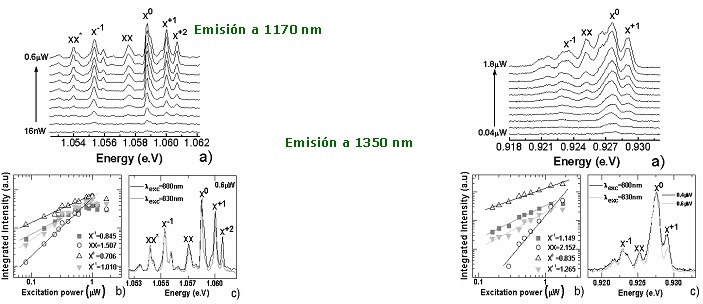
- We have also shown that the optical quality of an array of quantum dots is suitable as quantum sources of light, which reinforces their possible future use in devices for quantum information manipulation (as they can be placed wherever you want). This work was published in the journal ACS Nano 3, 1513-1517 (2009).
- We have also studied the exciton recombination as a function of temperature for InAs/InP quantum wires, with emission at telecommunications wavelengths, as active area photonic crystal cavities (see figure below). This has resulted in a paper being submitted to J. Phys D: Localization effects on recombination dynamics in InAs/InP self-assembled Quantum Wires emitting at 1.5 μm].
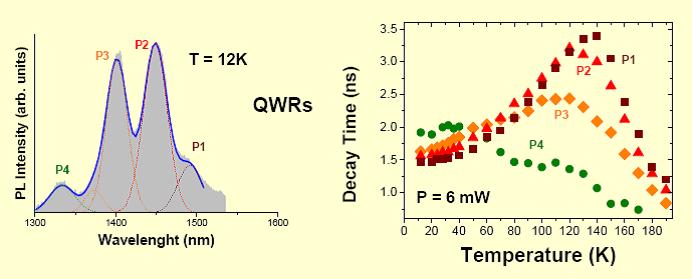
- Equipment
- Excitation
- 1 10W Ar+ laser(visible multi-line, Coherent) -see image below-.
- 1 doubled Nd:YAG laser (Green, Coherent) 532 nm, 5W.
- 1 tunable laser (700-1000 nm) Ti:sapphire (Mira 900-D from Coherent) pulse and CW.
- 1 Parametric optical wave generator. Ferroelectric crystal periodically polarized with line cavity and in ring for signal tuning in 1100-1600 nm and double of this (550-800 nm). It is designed (by APE Gmbh) to be pumped by the Ti:sapphire Mira 900-D laser both in ps and fs pulsed regime. Various diode lasers (670, 830, 980 nm) and 2 established power supplies of 2 A.

- Microscopy equipment
- Confocal optical microscope and SNOM with low temperature capability ATTOCUBE Gmbh consisting in:
-
Inmersion cryostat with variable temperature (4-77 K with liquid He, 77-300 K with liquid nitrogen).
-
Confocal microscope adapted to said cryostat.
-
Scanning near field optical microscope (SNOM) adapted to said cryostat.
-
Two xyz positioners based on inertial piezoelectric step motors (with nanometer resolution) and its electronic controller.
-
Configurable electronics for xy scan (subnanometre resolution) and focussing feedback (z). In-house controller software.
-
Closed electronics system from Nanotec for xy scan (subnanometre resolution) and focussing feedback (z). Nanotec developed controller software.
SNOM Setup
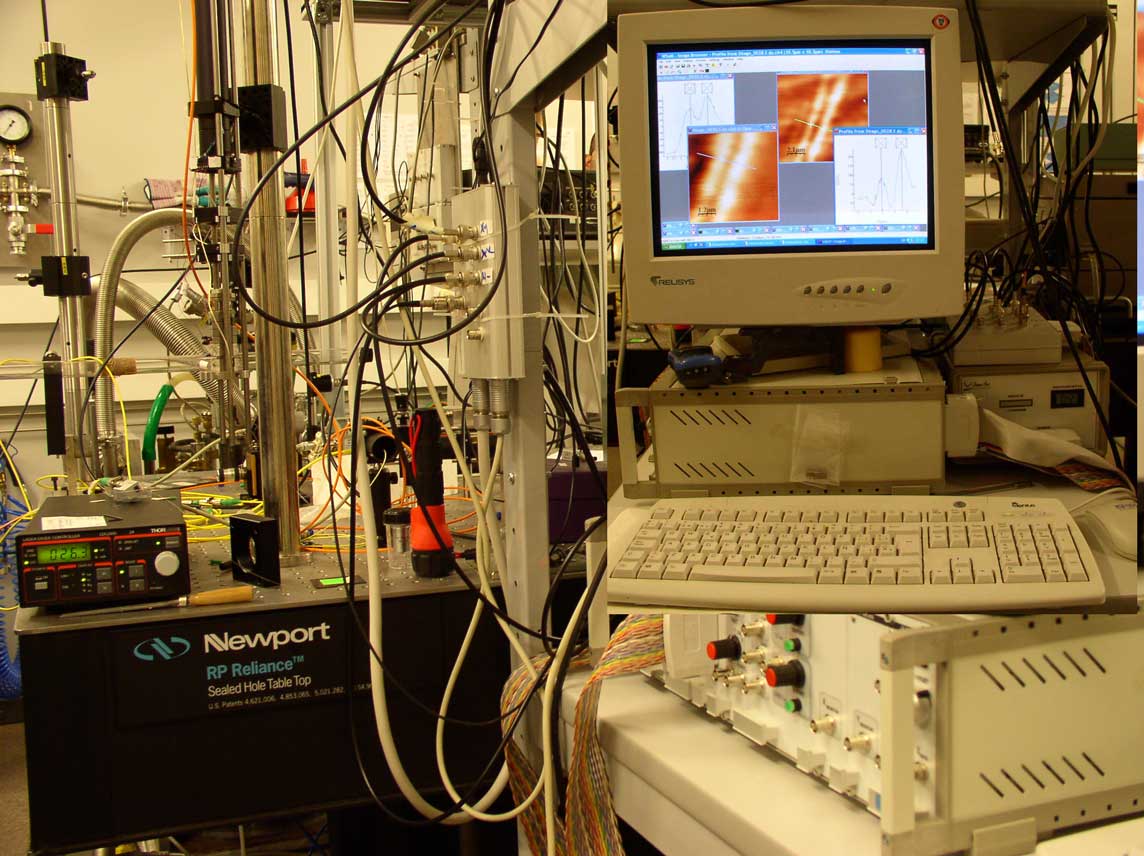
Some parts of the Confocal Microscope Setup
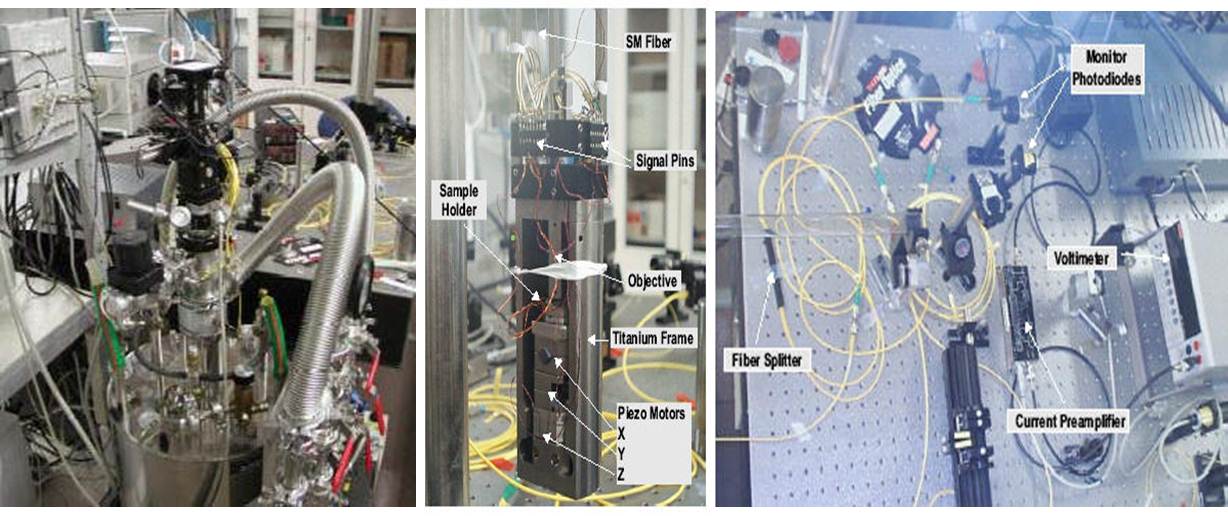
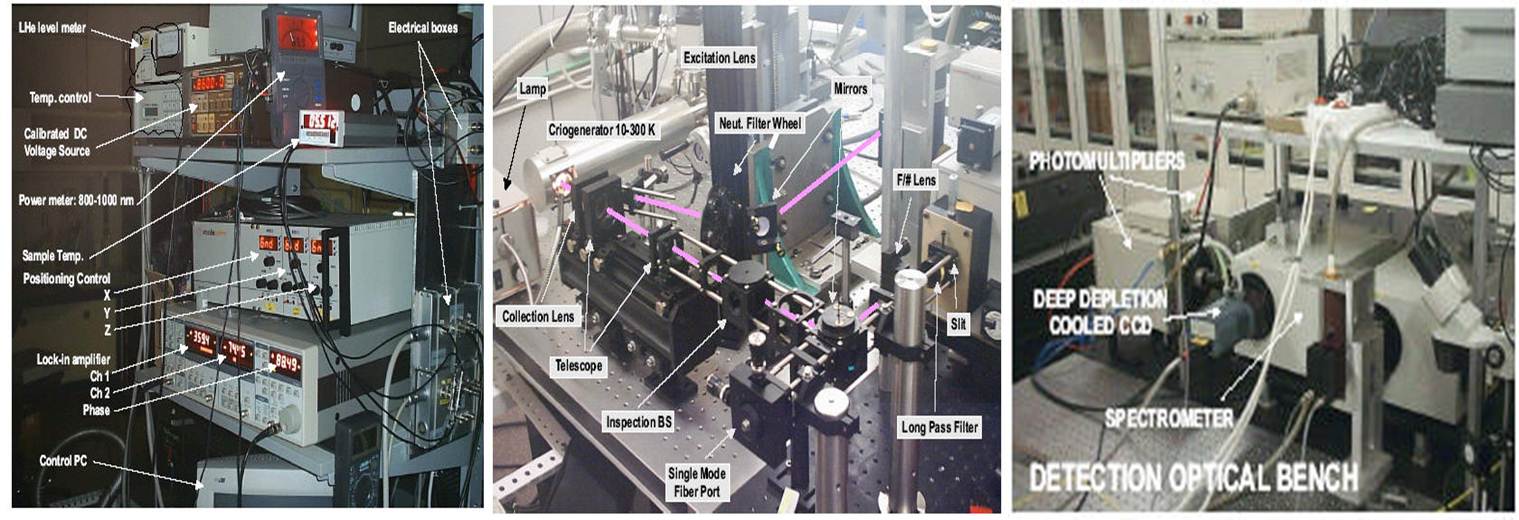
- Light Scattering
- 1 Spectrometer Chromex, simple f = 1/2 m.
- 1 double spectrometer from Acton Research, f = 300x2 mm, with double exit, in first and second spectrometer.
Time Resolved Photoluminescence Setup

- Detection
- CCD
- 1 Refrigerated CCD camera from Hamamatsu.
- Refrigerated "back thinned" CCD camera (-90 °C) by Andor. It is optimised for the detection of a NIR photon (quantum efficiency of 90% at 800 nm).
- UV-V-IR
- Various Si and InGaAs detectors (integrated preamplifier, ultrafast, APD).
- Refrigerated InGaAs detector: 800-1700 nm.
- InGaAs detector (with integrated peltier: 800-1600 nm, extended range: 1000-2100 nm).
- 1 multichannel photomultiplier 200-900 nm at ambient temperature.
- 1 refrigerated S1 photomultiplier: 300-1200 nm.
- 1 photomultiplier with InGaAs photocathode (low noise): 300-1050 nm.
- Multichannel system. A multichannel detection system for time resolved analysis of fluorescence and photoluminescence, consisting of:
- A Streak Camera (C5680-22S) with an S1 type photocathode for the detection in the range of 300-1600 nm with 4ps temporal resolution. This camera has entrance optics of A1976-01, synchronized rapid scanning M5675 with triggering by the p-i-n diode C1808-03, a C1097 retarder, and the assembly bench A1471-12.
- A refrigerated CCD camera with a wide dynamic range and high resolution (1280*1024 pixels). It couples to the Streak Camera via the optical exit A2886-04 and image capture takes place via a PC-DIG card from a PC. The HPD-TA software controls the adquisiton of the data via this card, besides the electronics of the Streak camera.
- Electronics
- 2 Lock-in amplifiers, Stanford SR810 y Stanford SR830.
- 3 Optical modulators for synchronization.
- 1 Boxcar amplifier for scanning/integration (Ext. Trigger 100 MHz, temporal resolution of 10 ps).
- 2 photon counting electronic modules.
- Others
- Electronic
- 1 Keithley Digital Multimeter 6.5 digits, with GPIB port.
- 1 High precision Keithley 230 power supply 0 +/- 100 Volts (50 mV), with GPIB port.
- 1 Quadtech LCR measurer (variable frequency), with GPIB port.
- Cryogenics, vacuum and optomechanical
- Various cryostats (He, N2)for electrical and optical measurements.
- 1 closed cycle cryostat with He compresor, ARS DE-202, 9-350 K.
- 1 rotary and turbomolecular vacuum pumps and measurement probes.
- 4 antivibrational optics tables.
- Precision optical and optomechanical material (Thorlabs/Newport/Owis) for spectroscopy and microspectroscopy.
Estimated Global value: ~900.000 €
 LEON
LEON





